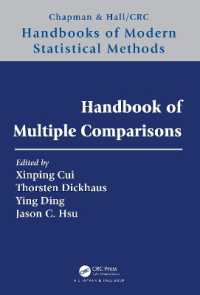- ホーム
- > 洋書
- > 英文書
- > Science / Mathematics
基本説明
Aimed at first and second year students in Ecology, Environmental Sciences, Geography, etc.
Full Description
This book introduces experimental design and data analysis / interpretation as well as field monitoring skills for both plants and animals. Clearly structured throughout and written in a student-friendly manner, the main emphasis of the book concentrates on the techniques required to design a field based ecological survey and shows how to execute an appropriate sampling regime. The book evaluates appropriate methods, including the problems associated with various techniques and their inherent flaws (e.g. low sample sizes, large amount of field or laboratory work, high cost etc). This provides a resource base outlining details from the planning stage, into the field, guiding through sampling and finally through organism identification in the laboratory and computer based data analysis and interpretation. The text is divided into six distinct chapters. The first chapter covers planning, including health and safety together with information on a variety of statistical techniques for examining and analysing data.Following a chapter dealing with site characterisation and general aspects of species identification, subsequent chapters describe the techniques used to survey and census particular groups of organisms. The final chapter covers interpreting and presenting data and writing up the research. The emphasis here is on appropriate wording of interpretation and structure and content of the report.
Contents
Tables. Figures. Boxes. Case Studies. Preface. Acknowledgements. 1 Preparation. Choosing a topic for study. Ecological research questions. Monitoring individual species and groups of species. Monitoring species richness. Monitoring population sizes and density. Monitoring community structure. Monitoring behaviour. A note of caution. Creating aims, objectives and hypotheses. Reviewing the literature. Primary literature. Secondary literature. Other sources of information. Search terms. Reading papers. Practical considerations. Legal aspects. Health and safety issues. Implementation. Time management. Project design and data management. Designing and setting up experiments and surveys. Types of data. Sampling designs. Planning statistical analysis. Choosing sampling methods. Summary. 2 Monitoring site characteristics. Site selection. Site characterisation. Habitat mapping. Examination of landscape scale. Measuring microclimatic variables. Monitoring substrates. Monitoring water. Other physical attributes. Measuring biological attributes. Identification. 3 Sampling static organisms. Sampling techniques for static organisms. Quadrat sampling. Pin-frames. Transects. Distribution of static organisms. Forestry techniques. 4 Sampling mobile organisms. General issues. Distribution of mobile organisms. Direct observation. Behaviour. Indirect methods. Capture techniques. Marking individuals. Radio-tracking. Invertebrates. Direct observation. Indirect methods. Capture techniques. Marking individuals. Capturing aquatic invertebrates. Netting. Suction sampling. Benthic coring. Drags, dredges and grabs. Wet extraction. Artificial substrate samplers. Baited traps. Capturing soil-living invertebrates. Dry sieving. Floatation and phase-separation. Tullgren funnels as a method of dry extraction. Chemical extraction. Electrical extraction. Capturing ground-active invertebrates. Pitfall traps. Suction samplers. Emergence traps. Capturing invertebrates from plants. Pootering. Sweep netting. Beating. Fogging. Capturing airborne invertebrates. Sticky traps. Using attractants. Refuges. Flight interception (window and malaise) traps. Light traps. Rotary traps. Water traps. Fish. Direct observation. Indirect methods. Capture techniques. Marking individuals. Amphibians. Direct observation. Indirect methods. Capture techniques. Marking individuals. Reptiles. Direct observation. Indirect methods. Capture techniques. Marking individuals. Birds. Direct observation. Indirect methods. Capture techniques. Marking individuals. Mammals. Direct observation. Indirect methods. Capture techniques. Marking individuals. 5 Analysing and interpreting information. Keys to tests. Exploring and describing data. Transforming and screening data. Spatial and temporal distributions. Population estimation techniques: densities and population sizes. Richness and diversity. Similarity, dissimilarity and distance coefficients. Recording descriptive statistics. Testing hypotheses using basic statistical tests and simple general linear models. Differences between samples. Relationships between variables. Associations between frequency distributions. More advanced general linear models for predictive analysis. Multiple regression. Analysis of covariance and multivariate analysis of variance. Discriminant function analysis. Generalized linear models. Extensions of the generalized linear model. Statistical methods to examine pattern and structure in communities: classification, indicator species and ordination. Classification. Indicator species analysis. Ordination. 6 Presenting the information. Structure. Title. Abstract. Acknowledgements. Contents. Introduction. Methods. Results. Discussion. References. Appendices. Writing style. Tense. Numbers. Abbreviations. Punctuation. Choice of font. Common mistakes. Computer files. Summary. References. Appendix 1 Glossary of statistical terms. Index.








